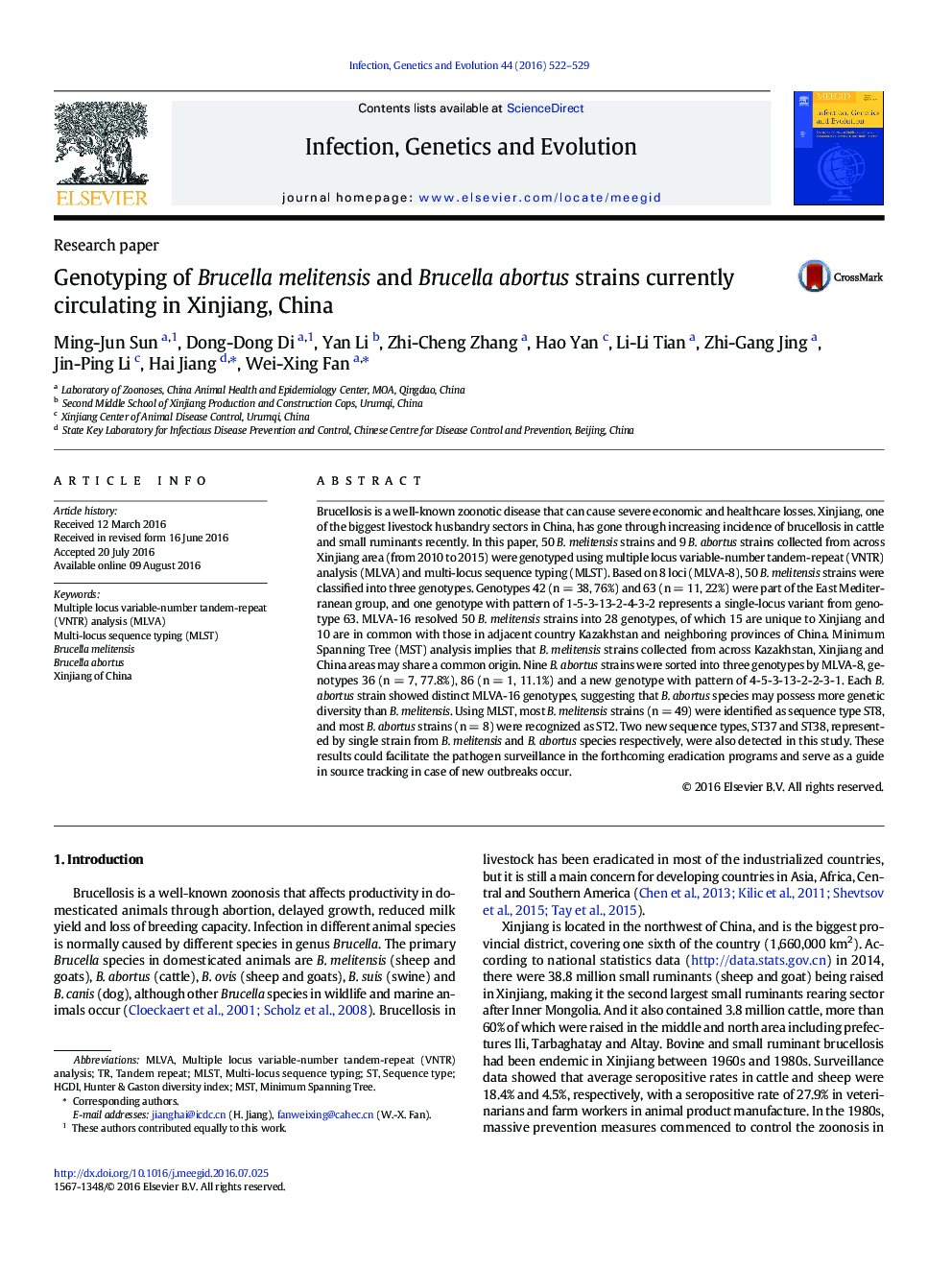| کد مقاله | کد نشریه | سال انتشار | مقاله انگلیسی | نسخه تمام متن |
|---|---|---|---|---|
| 5908232 | 1570159 | 2016 | 8 صفحه PDF | دانلود رایگان |
عنوان انگلیسی مقاله ISI
Genotyping of Brucella melitensis and Brucella abortus strains currently circulating in Xinjiang, China
دانلود مقاله + سفارش ترجمه
دانلود مقاله ISI انگلیسی
رایگان برای ایرانیان
کلمات کلیدی
موضوعات مرتبط
علوم زیستی و بیوفناوری
علوم کشاورزی و بیولوژیک
بوم شناسی، تکامل، رفتار و سامانه شناسی
پیش نمایش صفحه اول مقاله

چکیده انگلیسی
Brucellosis is a well-known zoonotic disease that can cause severe economic and healthcare losses. Xinjiang, one of the biggest livestock husbandry sectors in China, has gone through increasing incidence of brucellosis in cattle and small ruminants recently. In this paper, 50 B. melitensis strains and 9 B. abortus strains collected from across Xinjiang area (from 2010 to 2015) were genotyped using multiple locus variable-number tandem-repeat (VNTR) analysis (MLVA) and multi-locus sequence typing (MLST). Based on 8 loci (MLVA-8), 50 B. melitensis strains were classified into three genotypes. Genotypes 42 (n = 38, 76%) and 63 (n = 11, 22%) were part of the East Mediterranean group, and one genotype with pattern of 1-5-3-13-2-4-3-2 represents a single-locus variant from genotype 63. MLVA-16 resolved 50 B. melitensis strains into 28 genotypes, of which 15 are unique to Xinjiang and 10 are in common with those in adjacent country Kazakhstan and neighboring provinces of China. Minimum Spanning Tree (MST) analysis implies that B. melitensis strains collected from across Kazakhstan, Xinjiang and China areas may share a common origin. Nine B. abortus strains were sorted into three genotypes by MLVA-8, genotypes 36 (n = 7, 77.8%), 86 (n = 1, 11.1%) and a new genotype with pattern of 4-5-3-13-2-2-3-1. Each B. abortus strain showed distinct MLVA-16 genotypes, suggesting that B. abortus species may possess more genetic diversity than B. melitensis. Using MLST, most B. melitensis strains (n = 49) were identified as sequence type ST8, and most B. abortus strains (n = 8) were recognized as ST2. Two new sequence types, ST37 and ST38, represented by single strain from B. melitensis and B. abortus species respectively, were also detected in this study. These results could facilitate the pathogen surveillance in the forthcoming eradication programs and serve as a guide in source tracking in case of new outbreaks occur.
ناشر
Database: Elsevier - ScienceDirect (ساینس دایرکت)
Journal: Infection, Genetics and Evolution - Volume 44, October 2016, Pages 522-529
Journal: Infection, Genetics and Evolution - Volume 44, October 2016, Pages 522-529
نویسندگان
Ming-Jun Sun, Dong-Dong Di, Yan Li, Zhi-Cheng Zhang, Hao Yan, Li-Li Tian, Zhi-Gang Jing, Jin-Ping Li, Hai Jiang, Wei-Xing Fan,